-

人教版高中英语必修2Cultural Relics说课稿2篇
Ⅲ. Analysis of the teaching material:The topic of this unit is cultural relics. Students are quite interested in topics about different cultures around the world. This is the second period of the whole unit. As a reading class, the passage mainly talks about the history of the amber room (how it was made, sent as a gift, lost and rebuilt).According to the new national curriculum, when teaching reading, much emphasis should be put on training the students’ reading skills.Ⅳ. Teaching objectives1. Language objectives:1) Students are required to master the key words and phrases occurred in the passage (e.g. amazing, decorate, belong, in return, less than etc.)2) Students are required to learn the attributive clause and acquire the sentence pattern.2. 1) Students are required to describe a certain thing by using the new sentence patterns.2) Students are required to master two kinds of reading skills—skimming and scanning, and learn to use them in their daily reading.3. 1) Students are required to know the history of the amber room.2) Students are required to appreciate cultural relics and understand the importance of protecting them.Ⅴ. Teaching important and difficult points1) the new words, phrases, and sentence pattern in the course of reading.2) Teaching difficult point: Help the students master two kinds of reading skills—skimmingand scanning and learn to apply them in daily use.Ⅵ. Teaching methods:Task-based method & Top-down model Ⅶ. Teaching aids: PPT, pictures, blackboard Ⅷ. Teaching procedure:

人教版高中英语必修4A taste of English Humor说课稿3篇
Then I would ask them to think of a funny English or Chinese and tell it to partners. While telling stories, they can use expressions and some acting to help make the story funny. 5 minutes would be given to do this.Those stories they told there will be the material for their writing. Soletting them tell it at first is helpful. And they can make a difference between telling a funny story and writing it down. Generally speaking, it is difficult forstudents to write well because they don’t know what to write and how to write. Asking them to tell their own stories at first can help them come up with what to write.After their telling, I would invite someone to share his/her story with all of us and I would write it down on the blackboard.This example story would be used as a sample to illustrate the format of funny story. Different from a story from teacher or textbook, a story from students can obviously become a interesting material to draw students’ attention.Then I would ask the whole class to put this story into several parts. It might be a little bit difficult for them. So I would ask them to find out whether all the sentences are necessary. After delete some sentences, there are 6 sentences left behind. Then they can easily put them into three parts. After interaction with students, I would teach them the right terms for each part and conclude the format of funny story.This step is the key and difficult point in my lesson. So I mainly usetask-based teaching method in this part and the task for students was divided into several stages. With the separated difficult level, students can find there are usually three parts in writing. They can also learn to write without the unnecessary parts in the process of analyzing. And then I wouldn’t rush to tell them the right terms to them directly. Instead, I would ask them to name them by their own. A confused mind is better for acquiring knowledge.While-writing:Then I would give students 7 minutes to write down this story, without other requirements.With all the preparations in pre-writing, students’ difficulties were cleared. So it would be much easier for them to write down the story within 7 minutes. There are no other requirements because students’ first writing is actually a drafting. It would be revise and edit several times later. Writing, as a skill

人教版高中英语必修3Canada-the true north说课稿4篇
Good afternoon, teachers, It’s my great pleasure to be here sharing my lesson with you.The content of my lesson is Senior English Book 3 Unit 5 Canada —— “The true North”.I’ll be ready to begin this lesson from five parts. Analysis of the teaching material,the teaching methods,the studying methods, the teaching procedure,and Blackboard design.First, let me talk about the teaching material.Part 1 Teaching Material:This unit is about the introduction of Canada. By studying of this unit,we’ll enable the students to learn the geography, population, main cities, and natural beauty, natural resources of Canada. Through the training of the unit, it also requires students to learn some Language skills such as the expressions of position and emotions.So it plays an important part in the English teaching in this book.After studying the teaching material and analyzing the rule of children’s growing of mind,I think the teaching aims are the followings:1.Knowledge objects:(1) make the students learn some new words and phrases(2) make the students understand the content of the lesson.2.Ability objects:(1)To develop the Ss’ abilities of listening, speaking, reading and writing. Especially reading and speaking ability.(2) learn to talk about the characters of Canada in English(3)To train the Ss’ ability of working in pairs.3.Emotion objects:(1)Enable students to understand the characters of Canada..(2)Stimulate Ss to work hard to make China stronger.Part 2 Teaching Methods:I think helping students learn to master new words and phrases and improve the students’ reading and speaking ability is import and the difficult.According to the analysis of the teaching material and the import points and the difficult points,I will use the following teaching methods : question-guiding approach; fast-reading and careful reading; multi-media teaching methods; discussion

人教版高中英语必修3Healthy Eating说课稿4篇
Language learning needs a context, which can help the learners to understand the language and then can product comprehensible output, so computer has the advantages to make the materials attractive.Part 3 Learning MethodsTask-based, self-dependent and cooperative learningPart 4 Teaching ProcedureStep One Lead-in“Interest is the best teacher.” Therefore, at the very beginning of the class, I should spark the students’ mind to focus on the centre topic “the band”. I’ll show some pictures of food to attract their attention and then bring some questions.Question:What kind of food they like?What should go into a good meal?The answers must relate to the diet. After this, the students will be eager to know something about a balance diet and this is the very time to naturally lead the class into Step 2Step 2 Reading for information: skimming and scanning In this step, I use Task-based Language Teaching method, which can give students a clear and specific purpose while skimming and scanning the context.Task 1 General ideaThe students will be asked to just glance at the title and the pictures of the passage, and then guess what they will read in the text. And they’ll be divided into groups of four to have a discussion.The purpose is to inspire the students to read actively, not passively. In addition, the task is to develop the students’ reading skill by making prediction and to encourage the students to express their thoughts in English and cooperate with each other.Task 2 Main idea of each paragraphCooperative learning can raise the students’ interest and create an atmosphere of achievement. Based on this theory, I divide the whole class into 4 groups to skim the whole text and get the main idea of each paragraph.

人教版高中英语必修4Working The Land说课稿3篇
Knowledge objectives:(1) to make Ss grasp the usage of words, expressions and sentence structures: statistics, struggle, thanks to, rid of, some patterns for persuasion, the “ing” form as subject and object;(2)to use learnt knowledge to persuade sb.Ability objectives:(1) to develop Ss’ reading skills(skimming, scanning, word guessing);(2) to improve Ss’ speaking, communicating and cooperating skills.Emotional objectives:to make Ss know the contribution of Yuan,and learn his spirit and his simple life time.Teaching important and difficult points:(1) some words, expressions and sentence structures mentioned above;(2)the content of the text;(3)training their reading and speaking skills.Teaching methods: CLT, TBLT,QT.Learning strategies: CLS, QLS, TBLS.Teaching procedures:Step 1 lead-in: (1) teacher plays a piece of recent news from CCTV about the harvest of the super hybrid rice, and ask students whether they know Yuan or not, and talk about him and his contribution.(2)Brain storm: let Ss describe Yuan in their minds including his appearance, his living condition and so on.Step 2 fast reading tasks:(1)teacher introduces Yuan and super hybrid rice(2)make Ss read the text as fast as possible with questions. Such as: what’s the general ideaof this passage? What’s Yuan’ dream? (skimming and scanning skill)Step 3 intensive reading tasks(1)let Ss read the text silently, find topic sentence of each paragraph and draw the difficult sentences and the knowledge what they don’t understand.(words guessing)(2)teacher and Ss talk about the important words, expressions and sentences together, and ask Ss to retell the content of the text.(summarizing and paraphrasing)(3)teacher summarize this part.(4) read again following the courseware.

人教版高中英语必修5Life in the Future说课稿5篇
Good afternoon, everyone. It’s my great pleasure to be here sharing my lesson with you. The content of my lesson is Senior English for China Book5 Unit 3 Life in the Future. I’ll be ready to begin this lesson from six parts: Analysis of the teaching material, Analysis of the students, Teaching aims and important and difficult points, Teaching methods and aids, Teaching procedures, and Blackboard design. First, let me talk about the teaching material.Part 1 Analysis of the Teaching Material:This unit is about what human beings’ life will be like in about one thousand years. By studying of this unit, we’ll Enable the students to know the changes in humans’ life and some new inventions bringing about the change and develop the interest in science. This lesson plays an important part in the English teaching in this unit. This is an important lesson in Book Five. From this lesson, it starts asking the Ss to grasp contents of each passage. Therefore, this lesson is in the important position of the teaching material. If the Ss can learn it well, it will be helpful to make the Ss learn the rest of this unit.Part 2 Analysis of the SsAs Senior2 Ss, they are at different levels of English fluency, some of them have lost interest in English. So during the lesson, I arrange a variety of activities to let all of them join in to attract their interest and let them be confident and taste the joy of success.

人教版高中英语必修5Making the news说课稿4篇
今天我们来介绍一下必修五第四单元的授课方式。这个单元的题目是Making the news。应该是学生比较感兴趣的话题,学生往往对新闻工作充满好奇,所以我们可以利用这个机会多设计一些师生互动和学生互动,来激发起学习的积极性,提高学习效率。同时我们可以利用这个单元不仅帮助学生掌握语言知识,培养语言能力,同时让其了解新闻工作的重要性,培养起社会智能感。这个单元分为六个课时,它的教学目标是这样的:语言目标是掌握词汇表中的常用单词和短语,掌握倒装句的一些基本用法。 技能目标是能初步掌握约会的基本句型并在真实的场景下正确运用。新闻报道类文章的写作技能。采访的基本规范和沟通技能。情感目标是对新闻报道的客观性和真实性有更好的理解。对新闻记者的职业有更深入的了解,并能体会其工作的重要性。下面我们来介绍一下第一课时的授课方式,第一课的教学目标是这样的第一课时的教学目标语言目标:单词:Occupation, journalist, editor, photographer, curious, personality, enthusiasm
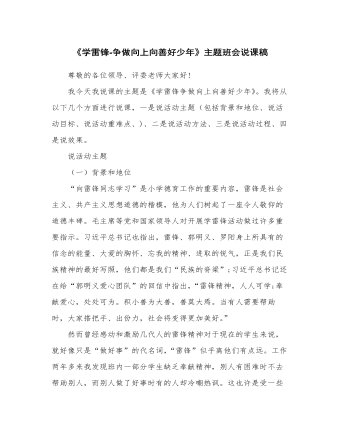
《学雷锋-争做向上向善好少年》主题班会说课稿
活动三——读《雷锋日记》让学生读雷锋给一位陌生老人送完手套后写的日记。重点理解“一路上,我的手虽冻得像针扎一样,心中却有一种说不出的愉快。”这一句话。让学生谈谈自己的感受。(此活动的目的是让学生了解雷锋的内心世界,理解雷锋精神的实质,全心合意为人民服务。)(三)讨论交流新时代还需要不需要学习雷锋?(1)小组讨论雷锋精神是不是已经过时了?新时代还用学雷锋吗?通过小组的讨论让学生认识雷锋精神的重要性,这是本次班会的重点内容,要引导学生积极参与,达到真正的思想教育。通过辩论后利用课件为学生们出示新时代的雷锋,《小林浩救人事迹》、感受社会的正能量。(设计本活动是让学生在讨论和辩论引起学生思想和情感的升华,更加深入理解雷锋精神对社会的重要性。)
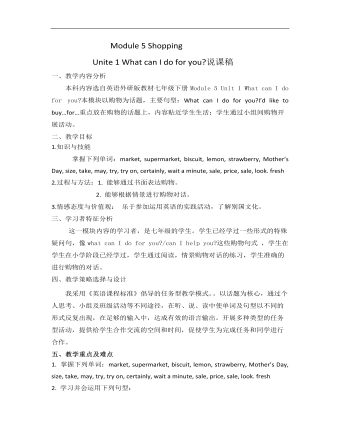
初中英语外研版七年级下册《Module 5 Shopping》说课稿
二、教学目标1.知识与技能掌握下列单词:market, supermarket,biscuit, lemon, strawberry, Mother’s Day, size, take, may, try, try on,certainly, wait a minute, sale, price, sale, look. fresh2.过程与方法:1. 能够通过书面表达购物。2. 能够根据情景进行购物对话。3.情感态度与价值观:乐于参加运用英语的实践活动,了解别国文化。

初中英语外研版七年级下册《Module 5 Shopping》说课稿
二、教学目标1.知识与技能掌握下列单词:market, supermarket,biscuit, lemon, strawberry, Mother’s Day, size, take, may, try, try on,certainly, wait a minute, sale, price, sale, look. fresh2.过程与方法:1. 能够通过书面表达购物。2. 能够根据情景进行购物对话。3.情感态度与价值观:乐于参加运用英语的实践活动,了解别国文化。三、学习者特征分析这一模块内容的学习者,是七年级的学生。学生已经学过一些形式的特殊疑问句,像what can I do for you?/can I help you?这些购物句式 ,学生在学生在小学阶段已经学过,学生通过阅读,情景购物对话的练习,学生准确的进行购物的对话。
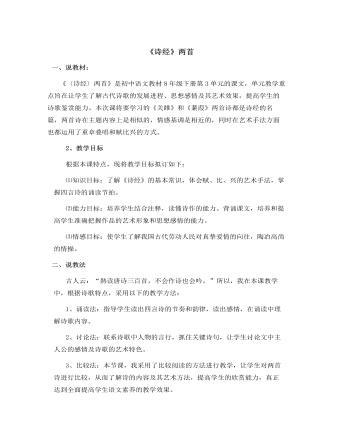
部编版语文八年级下册《诗经》二首 说课稿
一、说教材: 《〈诗经〉两首》是初中语文教材8年级下册第3单元的课文,单元教学重点旨在让学生了解古代诗歌的发展进程、思想感情及其艺术效果,提高学生的诗歌鉴赏能力。本次课将要学习的《关雎》和《蒹葭》两首诗都是诗经的名篇,两首诗在主题内容上是相似的,情感基调是相近的,同时在艺术手法方面也都运用了重章叠唱和赋比兴的方式。 2、教学目标根据本课特点,现将教学目标拟订如下:⑴知识目标:了解《诗经》的基本常识,体会赋、比、兴的艺术手法,掌握四言诗的诵读节拍。⑵能力目标:培养学生结合注释,读懂诗作的能力。背诵课文,培养和提高学生准确把握作品的艺术形象和思想感情的能力。⑶情感目标:使学生了解我国古代劳动人民对真挚爱情的向往,陶冶高尚的情操。
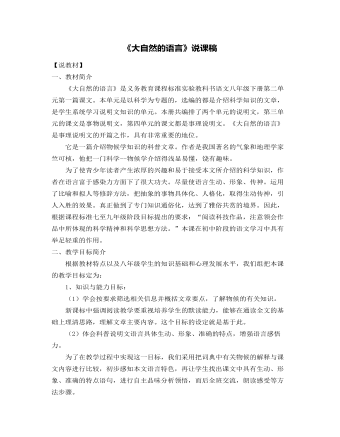
部编版语文八年级下册《大自然的语言》说课稿
二、教学目标简介根据教材特点以及八年级学生的知识基础和心理发展水平,我们组把本课的教学目标定为:1、知识与能力目标:(1)学会按要求筛选相关信息并概括文章要点,了解物候的有关知识。新课标中强调阅读教学要重视培养学生的默读能力,能够在通读全文的基础上理清思路,理解文章主要内容。这个目标的设定就是基于此。(2)体会科普说明文语言具体生动、形象、准确的特点,增强语言感悟力。为了在教学过程中实现这一目标,我们采用把词典中有关物候的解释与课文内容进行比较,初步感知本文语言特色,再让学生找出课文中具有生动、形象、准确的特点语句,进行自主品味分析领悟,而后全班交流,朗读感受等方法步骤。
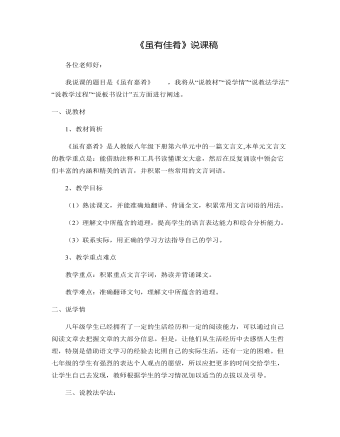
部编版语文八年级下册《礼记》二则 说课稿
一、说教材1、教材简析《虽有嘉肴》是人教版八年级下册第六单元中的一篇文言文,本单元文言文的教学重点是:能借助注释和工具书读懂课文大意,然后在反复诵读中领会它们丰富的内涵和精美的语言,并积累一些常用的文言词语。2、教学目标(1)熟读课文,并能准确地翻译、背诵全文,积累常用文言词语的用法。(2)理解文中所蕴含的道理,提高学生的语言表达能力和综合分析能力。(3)联系实际,用正确的学习方法指导自己的学习。3、教学重点难点教学重点:积累重点文言字词,熟读并背诵课文。教学难点:准确翻译文句,理解文中所蕴含的道理。
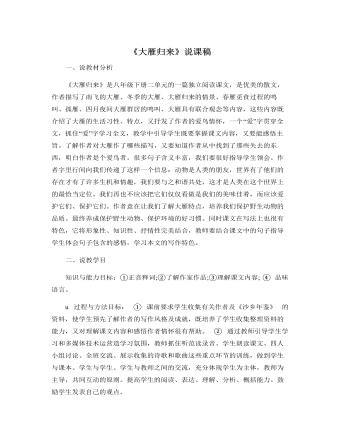
部编版语文八年级下册《大雁归来》说课稿
(三)阅读课文,整体感知。安排学生自由朗读课文,想想作者对大雁作了那些描写,勾出相关句子,想一想作者从大雁身上找到了那些“失去的东西”?这是在让学生充分发挥自己的个体作用,然后又安排四人小组讨论全班交流,意在合作探求,以便进一步领会所学的知识,最后教师利用多媒体展示参考内容,使学生进一步完整地掌握所学的知识。通过自己学、小组学、教师展示点拨,学困生也很容易地掌握所学知识,优生就更牢固地掌握了所学的知识。这样学生们对大雁的特点就有了较多了解,明白作者从大雁身上找回了什么,从中受到感悟。(三)精读课文,品味语言特点教师指导学生朗读一些优美的句子,指导学生从内容、修辞手法、说明方法、等方面去品味语言,利用多媒体来展示例句,加深学生印象,然后安排学生自己先找出课文中自己认为写的好的句子进行品味,然后四人小组讨论交流,最后全班交流,让学生资源共享。活动中我鼓励学生充分发表自己的观点,适时加以点拨,以此突破教学重难点。
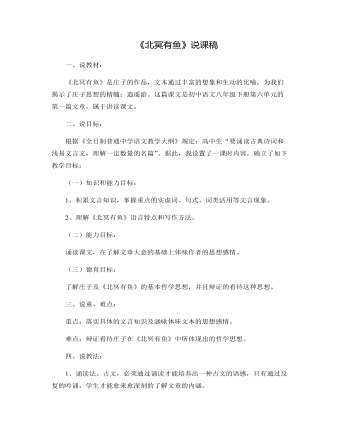
部编版语文八年级下册《庄子》二则 说课稿
一、说教材:《北冥有鱼》是庄子的作品,文本通过丰富的想象和生动的比喻,为我们揭示了庄子思想的精髓:逍遥游。这篇课文是初中语文八年级下册第六单元的第一篇文章,属于讲读课文。二、说目标:根据《全日制普通中学语文教学大纲》规定:高中生“要诵读古典诗词和浅易文言文,理解一定数量的名篇”。据此,我设置了一课时内容,确立了如下教学目标:(一)知识和能力目标:1、积累文言知识,掌握重点的实虚词、句式、词类活用等文言现象。2、理解《北冥有鱼》语言特点和写作方法。(二)能力目标:诵读课文,在了解文章大意的基础上体味作者的思想感情。(三)德育目标:了解庄子及《北冥有鱼》的基本哲学思想,并且辩证的看待这种思想。
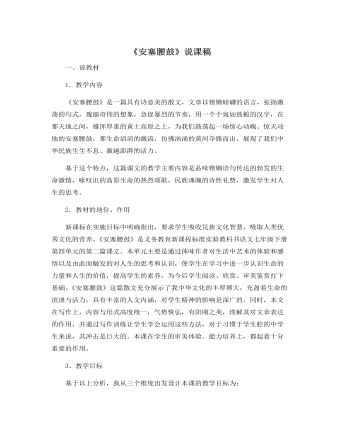
部编版语文八年级下册《安塞腰鼓》说课稿
1.教学内容《安塞腰鼓》是一篇具有诗意美的散文,文章以铿锵磅礴的语言,张扬激荡的句式,瑰丽奇伟的想象,急促暴烈的节奏,用一个个宛如鼓槌的汉字,在那天地之间,雄浑厚重的黄土高原之上,为我们鼓荡起一场惊心动魄、惊天动地的安塞腰鼓,那生命滔滔的激流,仿佛汹涌的黄河夺路而出。展现了我们中华民族生生不息、激越澎湃的活力。基于这个特点,这篇课文的教学主要内容是品味铿锵语句传达的勃发的生命激情,咏叹出的高原生命的热烈颂歌,民族魂魄的诗性礼赞,激发学生对人生的思考。2.教材的地位、作用新课标在实施目标中明确指出,要求学生吸收民族文化智慧,吸取人类优秀文化的营养。《安塞腰鼓》是义务教育新课程标准实验教科书语文七年级下册第四单元的第二篇课文。本单元主要是通过体味作者对生活中艺术的体验和感悟以及由此而触发的对人生的思考和认识,使学生在学习中进一步认识生命的力量和人生的价值,提高学生的素养,为今后学生阅读、欣赏、审美鉴赏打下基础。《安塞腰鼓》这篇散文充分展示了我中华文化的丰厚博大,充盈着生命的渲泄与活力,具有丰富的人文内涵,对学生精神的影响是深广的。
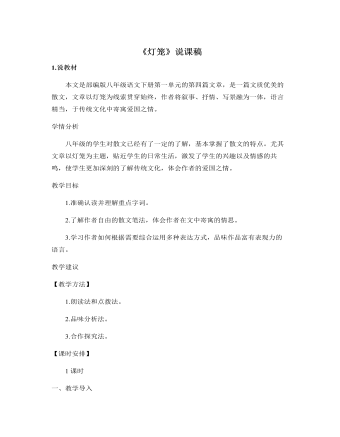
部编版语文八年级下册《灯笼》说课稿
主旨归纳本文以散文的自由笔法,抒写了作者关于灯笼的一些记忆,往昔经历、乡情民俗、诗词典故,从不同方面表达了灯笼对于作者乃至民族的重要意义。激发了作者的爱国情怀,同时表达了对时局的担忧和对未来的期望。重难导悟1.结合全文,简析作者喜爱灯笼的原因是什么?①灯笼寄托着祖父、母亲等亲人的慈爱和牵挂,也寄托着作者对亲人的感激之情;②许多乡情民俗与灯笼结下太多的缘分,给作者留下很多美好的回忆;③灯笼能为夜行人指路,温暖他人;④记录、传承着家族历史;⑤引发作者联想起古代将领挑灯看剑,抗击敌人的情景,激发爱国热情。2.文章结尾一段所表现的作者的观点态度是什么?请结合文章,进行分析并评价。作者热烈赞颂古代将军塞外点兵,挑灯看剑,英勇杀敌的气概;他们激发了作者的爱国情怀,作者热切希望冲上前线,奋勇杀敌,打击日寇;同时表达了对时局的担忧和对未来的期望,希望有更强大的力量,有更具凝聚力的精神,团结抗战,打败敌人,保卫好自己的家园。作者的爱国情怀值得肯定,这种情感在我们今天也是不可缺少的。
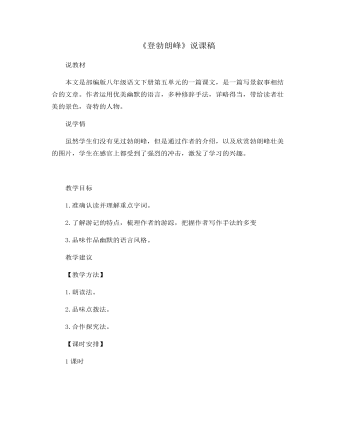
部编版语文八年级下册《登勃朗峰》说课稿
马克·吐温(1835-1910),美国幽默大师、小说家,19世纪后期美国现实主义文学的杰出代表之一。作品风格以幽默和讽刺为主,既富于独特的个人机智与妙语,又不乏深刻的社会洞察与剖析。主要的代表作品有《百万英镑》(短篇)等。此外,马克·吐温还有自己的四大名著:《哈克贝利·费恩历险记》《汤姆·索亚历险记》《败坏了哈德莱堡的人》《苦行记》等。勃朗峰是阿尔卑斯山脉最高峰,也是西欧第一高峰,海拔4807米,法语意为“银白色山峰”,位于法国和意大利边境。勃朗峰地势高耸,常年受西风影响,降水丰富。冬季积雪,夏不融化,白雪皑皑,山体约有200平方公里为冰川覆盖。勃朗峰设有空中缆车和冬季体育设施,为登山运动胜地;山峰雄伟,风光旖旎,为阿尔卑斯山最大旅游中心。勃朗峰下筑有公路隧道,起自法国的沙漠尼山谷到意大利的库马约尔,长11.6公里,1965年建成通车,使巴黎到罗马的里程缩短了约220公里。
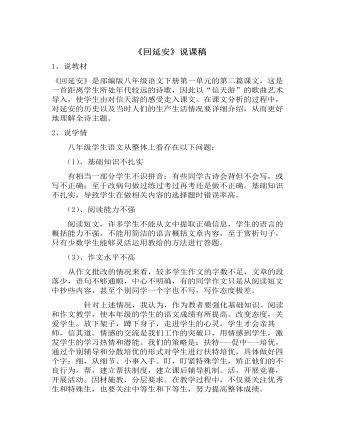
部编版语文八年级下册《回延安》说课稿
从作文批改的情况来看,较多学生作文的字数不足,文章的段落少,语句不够通顺,中心不明确,有的同学作文只是从阅读短文中抄些内容,甚至个别同学一个字也不写,写作态度极差。针对上述情况,我认为,作为教者要强化基础知识、阅读和作文教学,使本年级的学生的语文成绩有所提高。改变态度,关爱学生。放下架子,蹲下身子,走进学生的心灵,学生才会亲其师,信其道。情感的交流是我们工作的突破口,用情感到学生,激发学生的学习热情和潜能。我们的策略是:扶特---促中---培优,通过个别辅导和分散培优的形式对学生进行扶特培优,具体做好四个字:细,从细节、小事入手。盯,盯紧特殊学生,矫正他们的不良行为。帮,建立帮扶制度,建立课后辅导机制。活,开展竞赛,开展活动。因材施教,分层要求。在教学过程中,不仅要关注优秀生和特殊生,也要关注中等生和下等生,努力提高整体成绩。
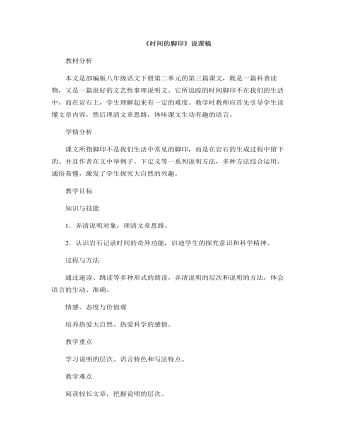
部编版语文八年级下册《时间的脚印》说课稿
一、新课导入 同学们,谁看见过时间?“逝者如斯夫,不舍昼夜”,孔子把时间比作一去不复返的流水;“光阴似箭,日月如梭”,在这里人们把时间比作为飞速的“箭”和“梭”…… 其实时间把它的脚印留在了许许多多我们不曾看到、不曾了解的地方。在那里,隐藏着的不仅仅是时间的脚印,而且还有无数的宝藏。例如,那千万年来躺在山野里的岩石,便是一部历史的教科书…… 今天,我们就来共同学习我国著名科普学家陶世龙的科普小品《时间的脚印》,和陶老先生一起走进大自然。二、关于岩石岩石分为三大类:火成岩、沉积岩、变质岩。沉积岩分为沙石岩和泥石岩,砾岩是沙石岩的一种。我们日常生活中见到的鹅卵石,和今天我们见到的雨花石,都是砾岩的一种。砾岩体积较大,内部有原始形态的鹅卵石和雨花石,质地较硬,称为“砾”;在“砾”和“砾”之间,有质地较细较软的岩石。它们紧挨在一起,形态有点像公园里的鹅卵石小道。当砾岩中较细较软的部分松动,原始形态的鹅卵石和雨花石就脱离开来,经过长期的水流搬运、冲击,被不断地磨圆,最后沉积在河床的底部。

